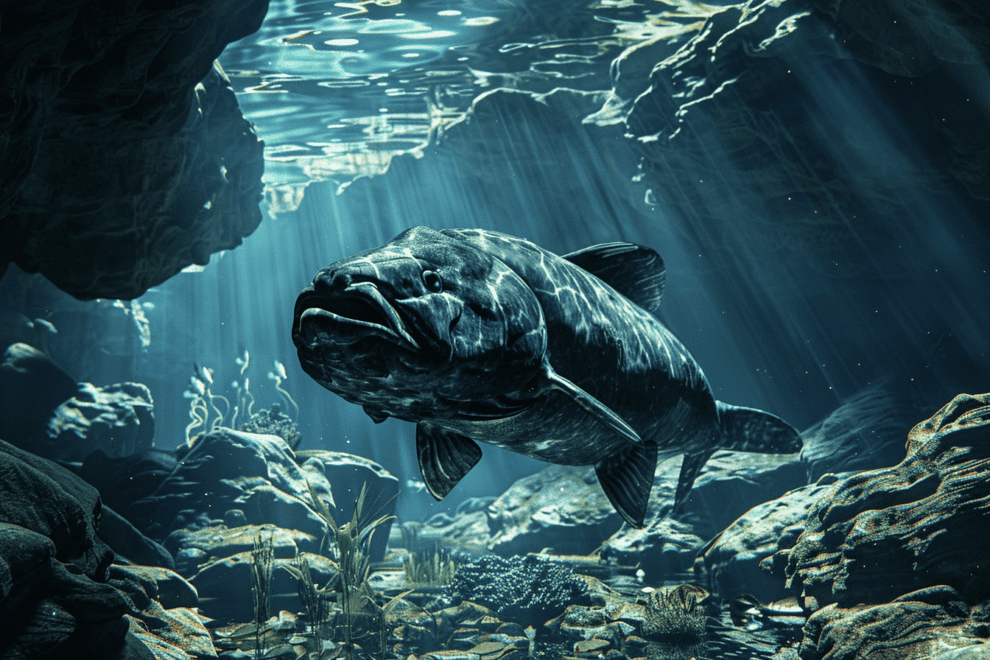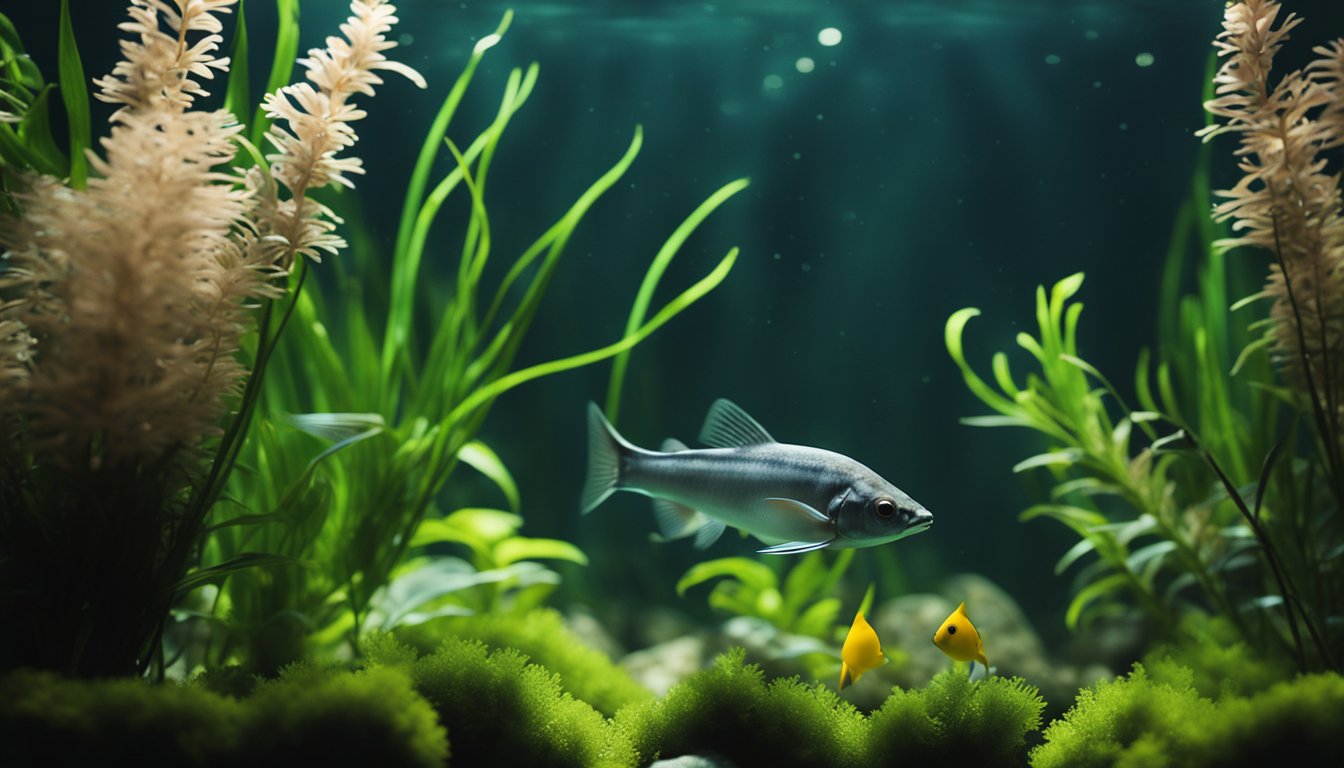You won’t believe the incredible tale of the coelacanth, a fish thought extinct for millions of years until its stunning rediscovery in 1938 off South Africa.
This ‘living fossil‘ dates back 400 million years and boasts unique features like lobe-finned limbs and a jointed skull.
Coelacanths thrive in deep-sea caves, using sensory pores to navigate their dark habitat. They can live up to 100 years, maturing at a glacial pace.
Critically endangered, these ancient survivors offer fascinating insights into vertebrate evolution and hold potential breakthroughs in biomedical research.
Discovery of the Coelacanth

The coelacanth, a ‘living fossil,’ was astonishingly rediscovered on December 22, 1938, off the coast of South Africa by museum curator Marjorie Courtenay-Latimer.
You can imagine the excitement when this ancient creature, believed extinct for 65 million years, suddenly appeared. Coelacanths, whose fossil record dates back to the Early Devonian Period around 410 million years ago, were thought to have vanished with the dinosaurs.
Marjorie Courtenay-Latimer’s rediscovery was nothing short of a scientific marvel.This rediscovery in South Africa sparked immense interest in the scientific community.
Researchers from around the globe flocked to study this ancient fish, keen to uncover secrets from a time long past. The coelacanth’s presence challenges our understanding of species survival and extinction, making it a living link to a world that existed millions of years ago.
Evolutionary Significance

Rediscovering the coelacanth in 1938 profoundly reshaped our understanding of evolutionary history and species survival.
You might find it fascinating that this fish first appeared during the Devonian Period, around 400 million years ago. For a long time, scientists believed it had vanished during the mass extinction following the asteroid strike that ended the Cretaceous Period.
However, the coelacanth was rediscovered alive, earning it the nickname ‘living fossil‘ due to its remarkable ability to remain largely unchanged over the millennia.
This discovery was like finding a piece of the ancient world in our modern oceans. Fossil records show that the coelacanth’s body structure has stayed consistent, retaining its ancient origins while other species evolved or went extinct.
A 400-million-year-old coelacanth fin fossil found in northern Wyoming further underscores its deep historical roots.
When Marjorie Courtenay-Latimer stumbled upon this ‘living fossil’ off South Africa’s coast, it wasn’t just a lucky find; it was a doorway to understanding how some life forms survive catastrophic events that wipe out others.
The coelacanth’s rediscovery and subsequent findings in the Comoros Islands have provided invaluable insights into the resilience and longevity of life on Earth.
Unique Physical Traits
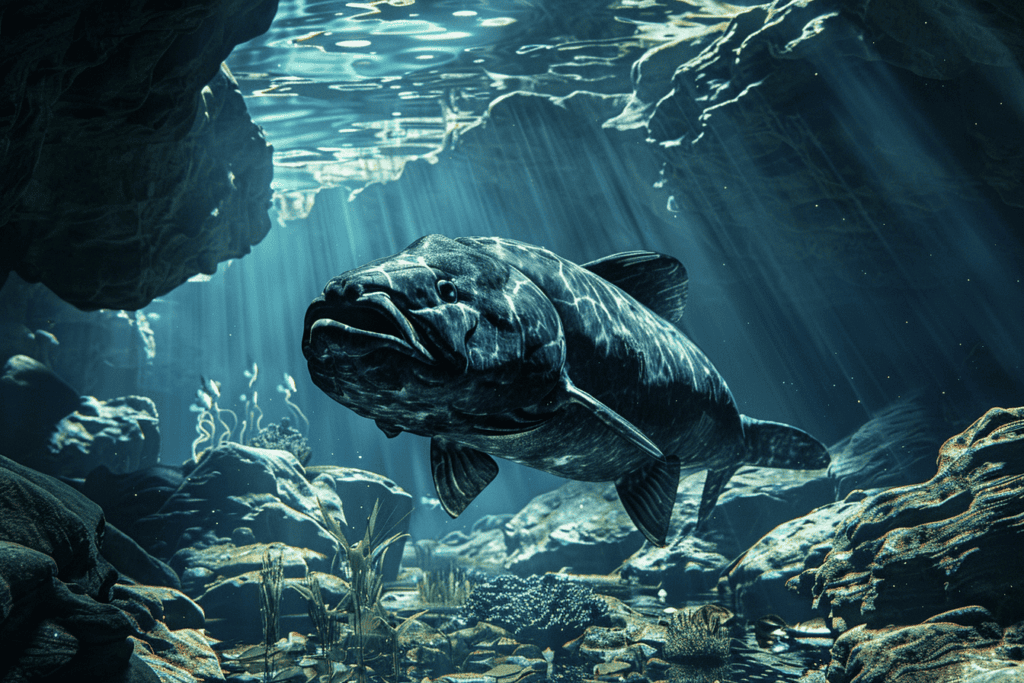
Among the coelacanth’s most striking features are its unique lobe-finned shape and symmetrical tail. Unlike other fish, its fins are attached to stalks, giving it a distinctive appearance.
This ancient species also boasts a jointed skull, allowing it to open its mouth widely, an adaptation shared with other primitive lobe-finned fish.
The coelacanth’s sensory pores are another fascinating trait. These large pores help the fish detect subtle changes in water pressure, providing a survival edge in its deep-sea habitat.
You’ll notice its thick scales, which are a pale mauvy blue, offering excellent camouflage in the ocean depths.
One of the coelacanth’s most unique features is its hollow fin, a characteristic that sets it apart from other marine life. Furthermore, it has a unique scale pattern that further distinguishes it.
These scales aren’t just for show; they’re integral to the coelacanth’s identity as a living fossil.
Growing up to 2 meters in length and weighing as much as 90 kilograms, the coelacanth is a true marvel of ancient aquatic life.
Its blend of primitive and unique physical traits makes it a fascinating subject for anyone interested in evolutionary biology. Meanwhile, its remarkable features have sparked scientific curiosity for centuries.
Ancient Habitat
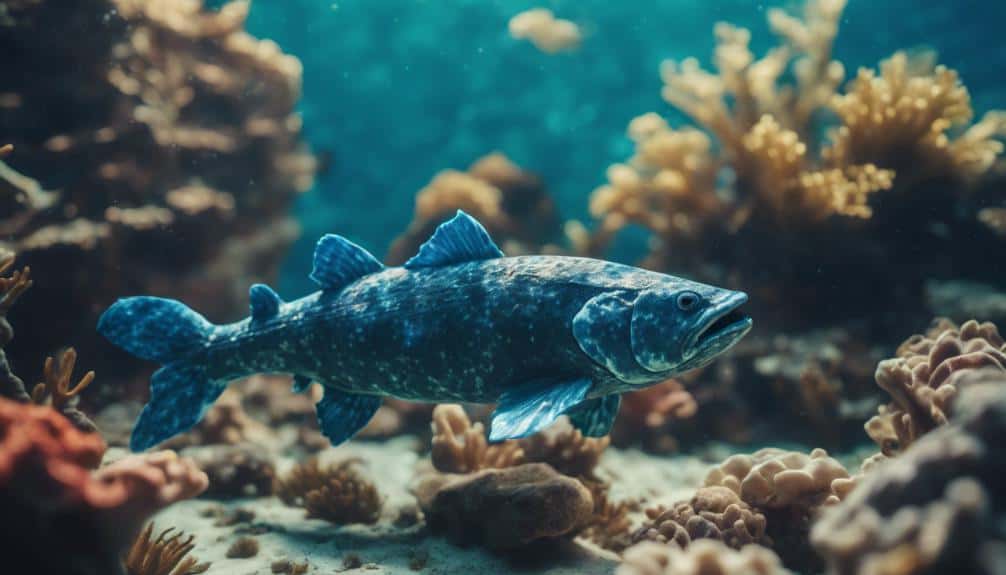
Coelacanths thrived in ancient marine environments that were drastically different from today’s oceans.
These remarkable fish found sanctuary in volcanic caves and the ocean depths, regions that provided protection from natural disturbances.
Along South Africa’s east coast and around the Comoro Islands, they could navigate their ancient habitat, evading predators and remaining hidden from the world for centuries.
The French oceanographic institution, which played a pivotal role in studying these living fossils, discovered that coelacanths preferred these isolated, deep environments.
They were well-adapted to survive where sunlight could barely penetrate, enabling them to thrive away from prying eyes.
Their ancient habitat offered stability in a fluctuating oceanic landscape.
Volcanic caves provided not just refuge but also a consistent environment.
This stability allowed the coelacanths to remain relatively unchanged for millions of years, earning them the title of ‘living fossils.’
Their existence in such depths, far removed from human interference, helped preserve their lineage, a tribute to the enduring nature of their ancient habitat.
Evolutionary Insights

While coelacanths found refuge in their ancient habitats, their unique evolutionary traits provide invaluable insights into the history of vertebrate evolution.
These lobe-finned fish, dating back to the Devonian Period, serve as a living snapshot of a time when the first tetrapods began to emerge. Their jointed skulls and lobe-finned limbs have remained largely unchanged for 400 million years, offering a window into the shift from aquatic to terrestrial life.
Coelacanths grow at the slowest pace, with a lifespan reaching roughly 100 years, making them one of the longest-living fish.
This centuries-old species also exhibits the longest-known gestation period in the fish world, lasting about three years. Such traits highlight the unique aspects of coelacanths’ life history and provide clues about the evolution of longevity in vertebrates.
Marine evolutionary ecologists study these fascinating creatures to understand how they survived extreme climate events that wiped out many other species.
By examining coelacanth DNA, scientists gain insights into ancient genetic blueprints, contributing to advancements in medical research and biomedical engineering.
The coelacanth’s enduring presence offers a rare glimpse into the evolutionary processes that have shaped life on Earth.
Modern Research Efforts
In recent years, groundbreaking studies have shed new light on the remarkable biology and longevity of coelacanths.
Researchers have discovered that these ancient creatures can live nearly 100 years, making them one of the longest-living vertebrates.
This revelation was made possible by examining annual growth rings on the fish’s scales, much like counting tree rings to determine age.
These growth rings have also revealed details about the coelacanth’s slow development.
You’d be amazed to learn that coelacanths don’t reach sexual maturity until they’re about 55 years old.
Even more astonishing, female coelacanths have the longest-known gestation period of any animal, carrying their young for five years.
This slow pace of life is a fascinating aspect of fish biology, highlighting just how unique these living fossils are.
The study, which focused on African coelacanths, used scales from 27 individuals housed in museum collections.
The insights gained are vital for conservation efforts, helping scientists understand what these ancient creatures need to survive.
As we explore deeper into the coelacanth’s biology, it’s clear that protecting these extraordinary fish is essential for preserving a link to our planet’s distant past.
Biomedical Implications For Humans
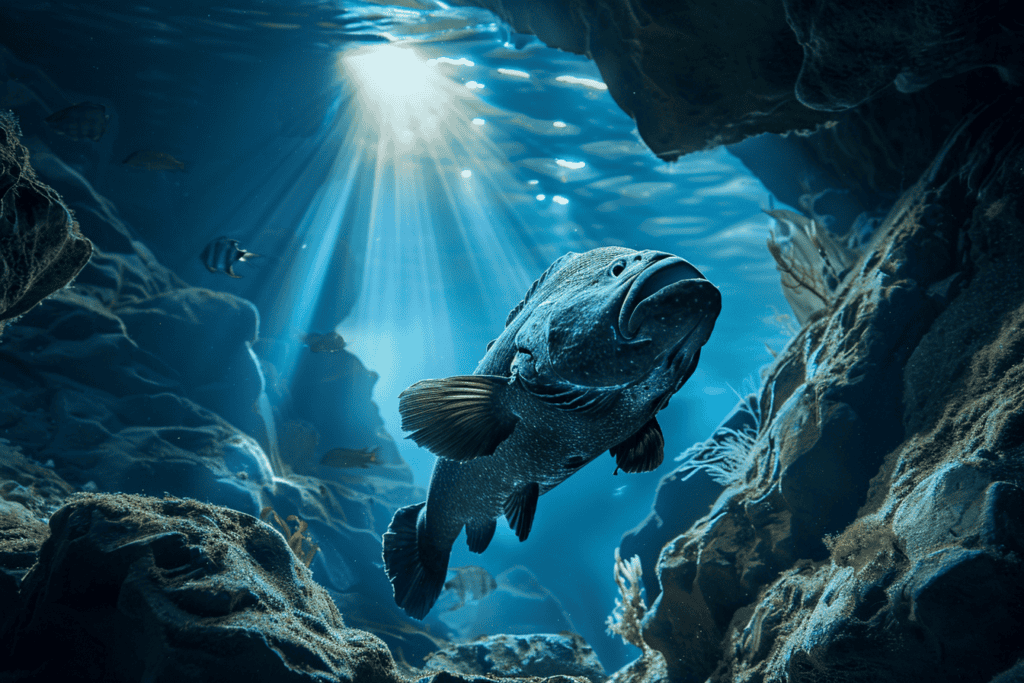
The coelacanth’s ancient genetic makeup has revealed groundbreaking insights into medical research and innovation.
This remarkable fish’s longevity and slow growth rate have piqued the interest of scientists studying telomere maintenance, offering potential breakthroughs in combating age-related diseases. By examining how coelacanths maintain their genetic integrity over such long lifespans, researchers hope to decipher secrets that could one day extend human life.
Additionally, the coelacanth’s efficient oxygen supply system has sparked advances in biomedical engineering.
Innovations inspired by this fish include artificial oxygen carriers and new oxygen therapies, which could revolutionize treatments for patients with respiratory issues. The coelacanth’s ability to survive in low-oxygen environments, known as hypoxia tolerance, has also provided valuable insights into the molecular mechanisms that allow it to thrive under such conditions. This knowledge could lead to improved strategies for treating conditions like stroke and heart disease.
In cancer research, the coelacanth’s unique genetic makeup has shed light on tumor suppression.
Frequently Asked Questions
How Do Coelacanths Reproduce?
Coelacanths practice ovoviviparous reproduction. Their gestation period lasts five years. After mating and egg fertilization, females develop offspring internally. They reach sexual maturity at 55, with breeding seasons influenced by environmental changes. Parental care is minimal.
What Do Coelacanths Eat in Their Natural Habitat?
In their natural habitat, coelacanths’ diet diversity includes fish, squid, and crustaceans. Their nocturnal hunting and ambush predation tactics reflect their adaptive feeding habits to food scarcity. Habitat influences their foraging behavior and marine diet within their ecological niche.
Are There Cultural Myths or Legends About Coelacanths?
You’ll find coelacanths wrapped in underwater myths and ancient tales. Various tribal stories depict them as mystical beings, mythical fish in marine folklore. These ocean legends often highlight legendary encounters and cultural symbolism surrounding these folklore creatures.
How Can One Identify a Coelacanth?
To identify a coelacanth, look for its unique scales, distinct lobe fins, blue color, large eyes, and unusual tail shape. Pay attention to its fin structure, prominent dorsal and pelvic fins, and unique movement. It’s a true living fossil.
Are Coelacanths Kept in Aquariums or Marine Parks?
You’ll find coelacanths rarely in aquariums or marine parks due to aquarium challenges and strict habitat requirements. Proper tank design, water quality, and feeding regimes are hard to maintain, making captive breeding nearly impossible. Conservation efforts prioritize natural habitats.

